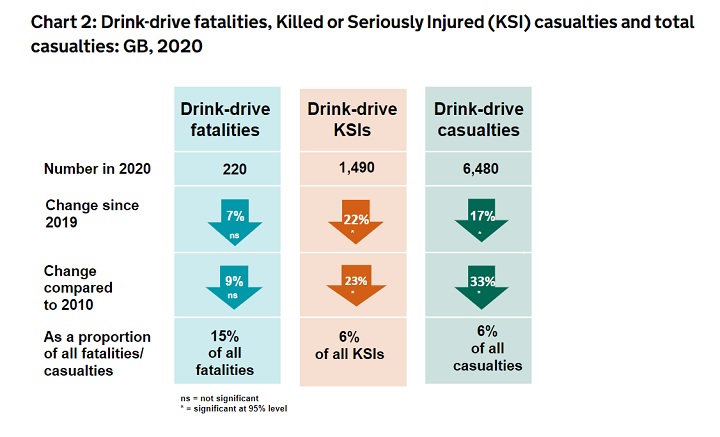
While the number of people killed in drink-drive related collisions fell slightly in 2020, the RAC has expressed concern over the wider picture.
The DfT’s final estimates for 2020 show that between 200 and 240 people were killed in collisions where at least one driver was over the drink-drive limit – leading to a central estimate of 220 deaths.
The central estimate is the lowest since 2015 – and down 4% from 230 in 2019.
However, it must be remembered that 2020 was a year heavily impacted by the Covid-19 pandemic, which also saw the total number of road deaths fall by 17% and traffic levels drop by 21% when compared to the previous year.
This means that the percentage of drink-drive fatalities – as a proportion of all fatalities – increased to 15%, the highest figure in more than a decade.
This rise has concerned the RAC.
Simon Williams, RAC road safety spokesperson, said: “While the overall picture of the number of drink-drive-related collisions on our roads being at record lows is welcome, it’s important to note these figures were gathered during the height of the pandemic.
“Unfortunately, the wider picture shows the percentage of drink-drive fatalities on our roads as a proportion of all fatalities has increased, meaning the campaign against drink-driving is just as important as it has ever been.
“Drivers themselves tell us they want to see more roadside breathalyser testing taking place as well as alcolocks fitted to vehicles of repeat drink-drivers to prevent them from reoffending. Our message is simple and stark: if you’ve been drinking, don’t drive.”
Road Safety GB says it is important that efforts to achieve greater casualty reduction continue.
James Gibson, executive director of Road Safety GB, said: “While the overall statistics thankfully show a downward trend, drink driving remains a significant issue and it must be acknowledged that Covid lockdown restrictions and fewer journeys will have contributed to casualty reductions.
“Therefore the work on education, behaviour change and enforcement must continue in order to achieve greater casualty reduction in the future.”
Meanwhile, breathalyser firm Alcosense has used the figures to renew its call for a lower drink-drive limit in England, Wales and Northern Ireland.
Hunter Abbott, managing director of AlcoSense, said: “What these figures don’t tell you is how many more casualties were caused by ‘lethal but legal’ drivers – those who were above the point of intoxication where effects on cognitive function occur, but below the official drink drive limit.
“The limit in England, Wales and Northern Ireland is the highest in Europe and the joint highest anywhere in the developed world.”
We are NOT making progress on drink drive. Good for the RAC.
David Davies
--1